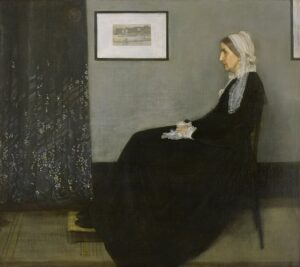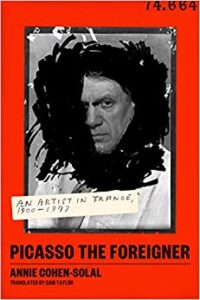Four big stories dominated the art world this week:
- On the upcoming cover of The New Yorker, a courtroom artist’s sketch of Trump.
- Whistler’s Mother re-visits Philadelphia (last seen in 1881) in a grand exhibit on Motherhood at the Philadelphia Art Museum.
- Picasso fans celebrate the 50th anniversary of his passing with worldwide museum shows and worldwide art criticism.
- The movie Paint, starring Owen Wilson, is a look alike for the art-cult 1980s icon Bob Ross, and critics pan it.
Trump In Court
 Traditionally the cover of The New Yorker stays away from overtly pollical images. They certainly never featured a defendant in court. This trial is special. A sketch by Jane Rosenberg, a 40 year veteran artist of the courtroom, lands her image of Donald Trump on the cover of The New Yorker. The image portrays the former President during a hearing related to his indictment. Many jurisdictions don’t allow cameras in court to protect privacy and prevent distractions. Print media has relied on courtroom sketch artists since the mid-19th century. No other courtroom sketch will ever reach such a level of fame.
Traditionally the cover of The New Yorker stays away from overtly pollical images. They certainly never featured a defendant in court. This trial is special. A sketch by Jane Rosenberg, a 40 year veteran artist of the courtroom, lands her image of Donald Trump on the cover of The New Yorker. The image portrays the former President during a hearing related to his indictment. Many jurisdictions don’t allow cameras in court to protect privacy and prevent distractions. Print media has relied on courtroom sketch artists since the mid-19th century. No other courtroom sketch will ever reach such a level of fame.
Whistler’s Mother Has a Sit-Down At the Philadelphia Art Museum
 The first American display of the famous painting Arrangement in Grey and Black No.1 (1871) happened in Philadelphia in 1881 at the Pennsylvania Academy. Although James Abbott McNeill Whistler was born an American, his strong-willed mother opposed the American Civil War. At age 59 she moved with Whistler to London in 1863. She assisted her son in his studio in Chelsea as his manager. He created the painting of Mom, Anna Mathilda, in London in 1871. Then sold the portrait to the French Government in 1891 for the Louvre collection.
The first American display of the famous painting Arrangement in Grey and Black No.1 (1871) happened in Philadelphia in 1881 at the Pennsylvania Academy. Although James Abbott McNeill Whistler was born an American, his strong-willed mother opposed the American Civil War. At age 59 she moved with Whistler to London in 1863. She assisted her son in his studio in Chelsea as his manager. He created the painting of Mom, Anna Mathilda, in London in 1871. Then sold the portrait to the French Government in 1891 for the Louvre collection.
The work comes to America from France as part of a group show depicting visions of motherhood by artists who painted their own mothers. Hailed as the American Mona Lisa, Whistler’s Mother is NOT an American painting, but it became an icon during the Dust Bowl years. Americans so revered the piece that the government featured it on a US postage stamp.
How should we SEE Pablo?
 Pablo Picasso died April 8, 1973. His controversial life is reexamined fifty years later. Should we rely on his biography for clues about this great artist, or should his work speak for itself? Museums worldwide are reassessing Picasso’s legacy with exhibits, discussions, and books fifty years after his death.
Pablo Picasso died April 8, 1973. His controversial life is reexamined fifty years later. Should we rely on his biography for clues about this great artist, or should his work speak for itself? Museums worldwide are reassessing Picasso’s legacy with exhibits, discussions, and books fifty years after his death.
The New York Times recently interviewed ten prominent practicing artists about Picasso’s undeniable influence. One said, “His Bio is Boring.” Meaning it should focuses only on his WORK.
On the other hand, a new book recently translated into English takes the other tack. Picasso the Foreigner by Annie Cohen-Solal discusses a lifetime of Picasso surveillance by the intelligence agencies of his adopted country France. In 1900 a young, impoverished Picasso came to Paris. French police targeted him a possible anarchist, and later suspected he harbored Communist leanings. They considered him such a danger to France that when at the age of fifty-nine he requested citizenship, after living in France for forty years, they DENIED it.
Today the art world considers his art superior to his daily life, his many women, his tortured politics. But that was not always the case. In 1957 the Museum of Modern Art NY prohibited his presence at their blockbuster Picasso show, because J Edgar Hoover deemed him “a threat to American Security.” MOMA showed his great works, such as Les Demoiselles d ’Avignon and Guernica, but didn’t welcome the artist.
He REMAINS controversial today. Comedian Hannah Gadsby’s 2018 show Nanette decried his so-called misogyny, masculinity, creativity, and male-type bravado. Since she made a splash with her Picasso opinion, the Brooklyn Museum of Art asked her to mount a Picasso show for the fiftieth anniversary of his death.
ArtNews Pans Owen Wilson Film Paint
 Actor Owen Wilson stars as wannabee artist, star Bob Ross, the feel good 1980s TV host, in the new film Paint.
Actor Owen Wilson stars as wannabee artist, star Bob Ross, the feel good 1980s TV host, in the new film Paint.
The Aptly titled show The Joy of Painting became a cultural blockbuster on TV (1983-1994). It made a star of artist Bob Ross. The show aired four hundred episodes, entertained five-million viewers, and captured the imaginations of SUNDAY painters. I still find such 1980s canvases in garages in Santa Barbara!
Bob Ross’s legacy therefore lives on, but the movie Paint by Brit McAdams sidesteps Bob Ross-ness, according to critics. ArtNews said, “The film’s instance upon avoidance of any so-called transgressions comes off as an effort to steer clear of legal issues regarding the Ross estate.”
How much MONEY is at stake from those four-hundred episodes and all that BRANDING? A Netflix documentary last summer, Bob Ross: Happy Accidents, Betrayal and Greed examined the issue. He died in 1995 and the battle wages between former business managers, family, and other interests regarding Ross’s estate. Owen Wilson, as popular 1980s artist Carl Nargle, sports a blond fro and paints “wet on wet” like Ross did.